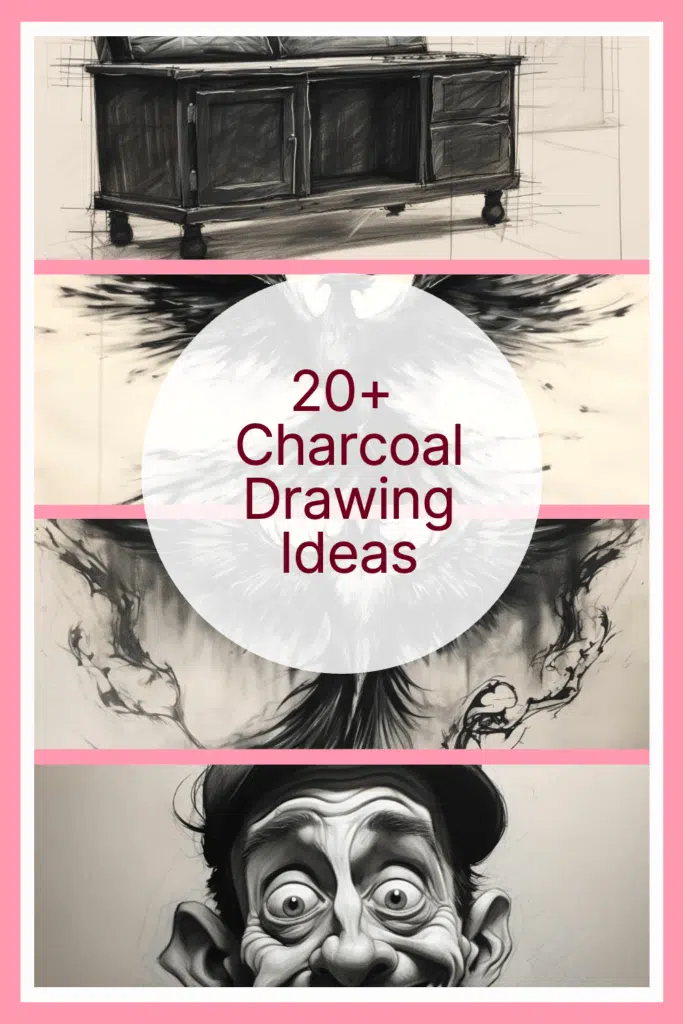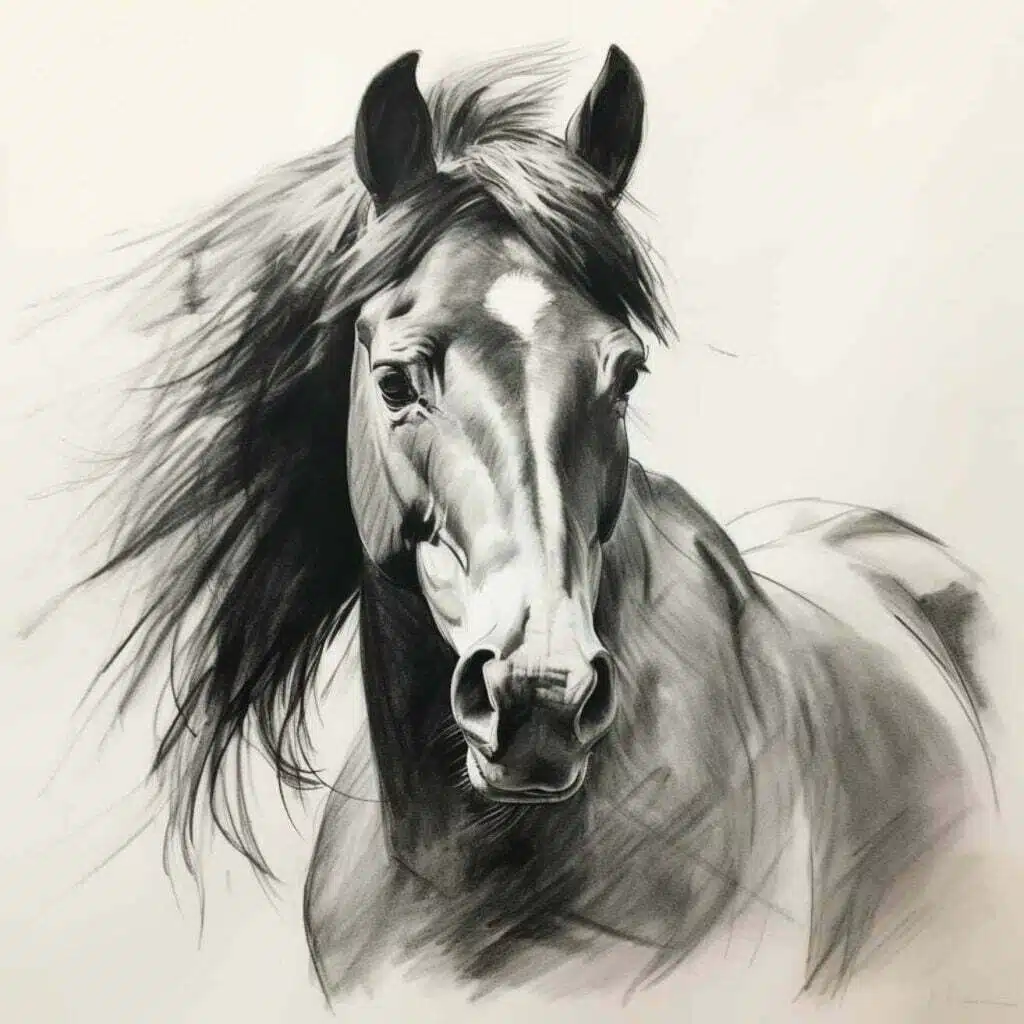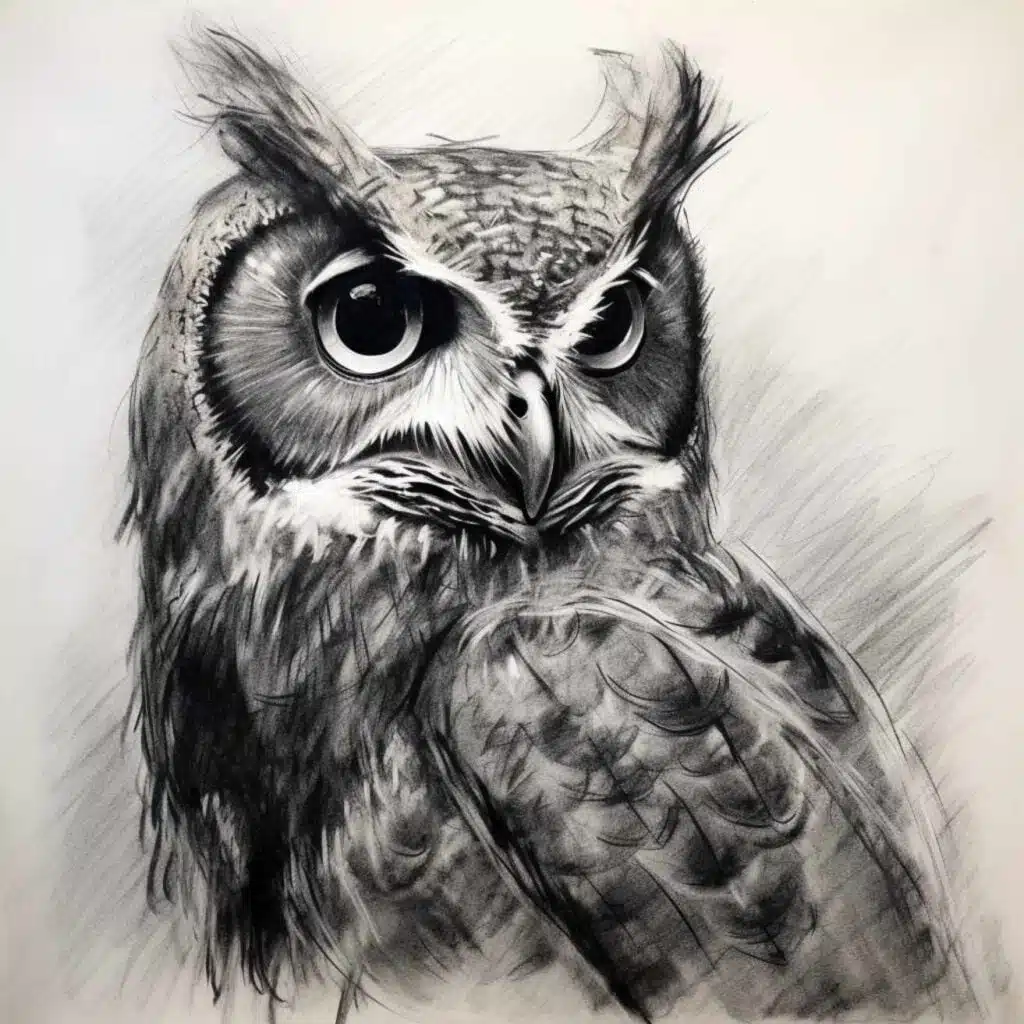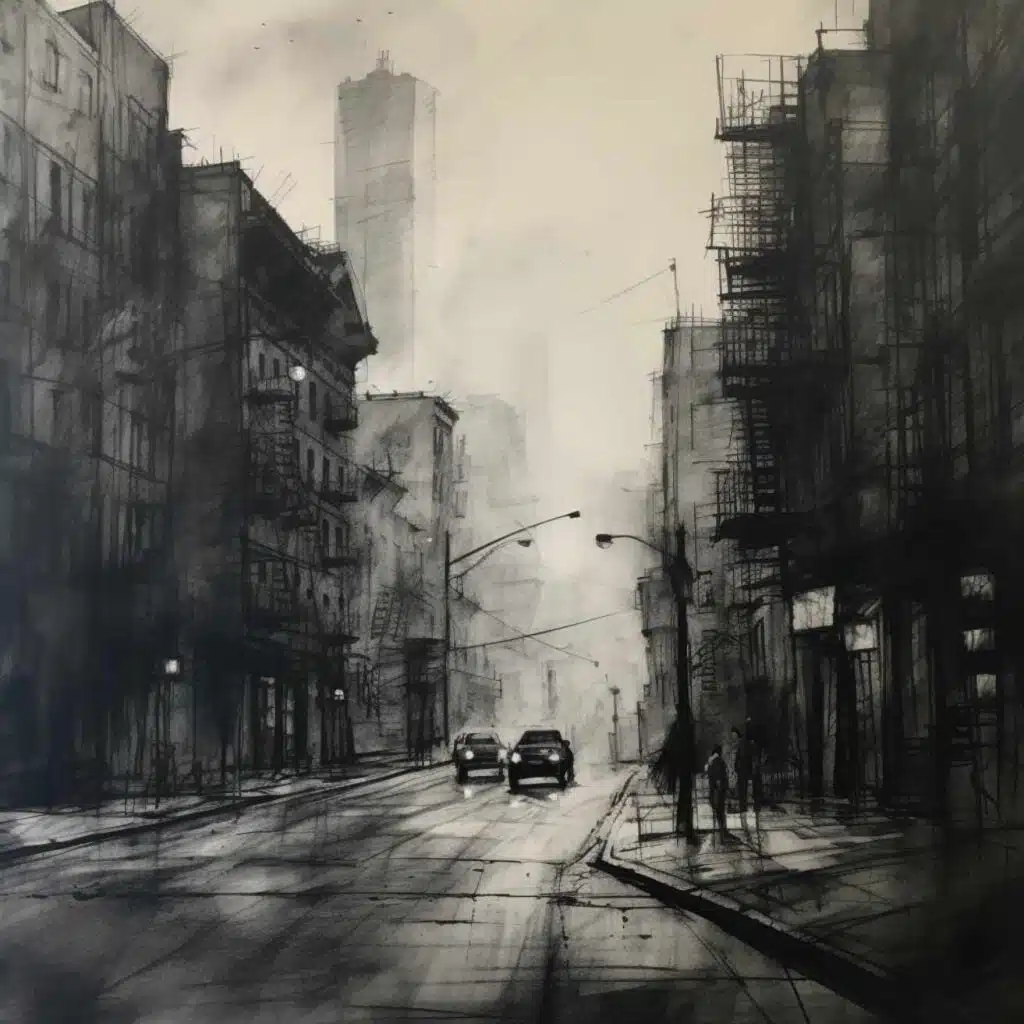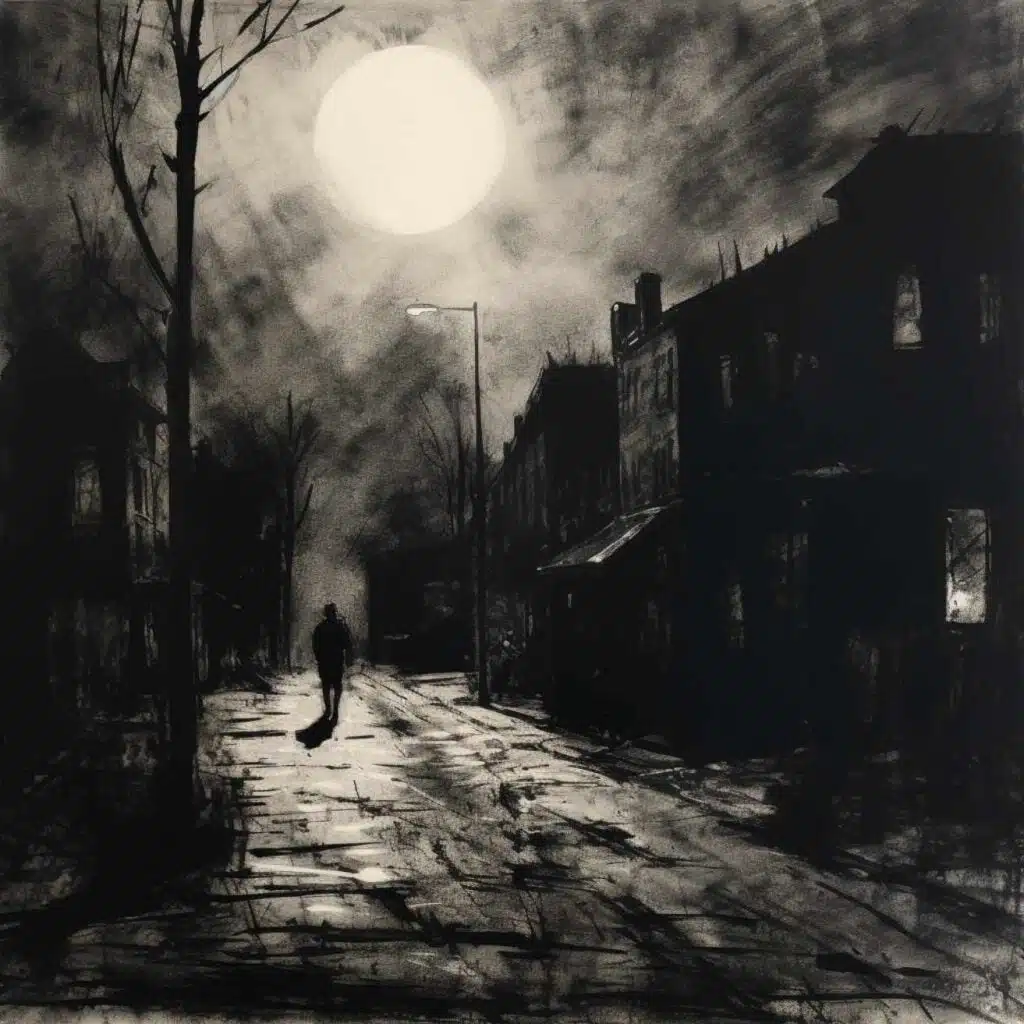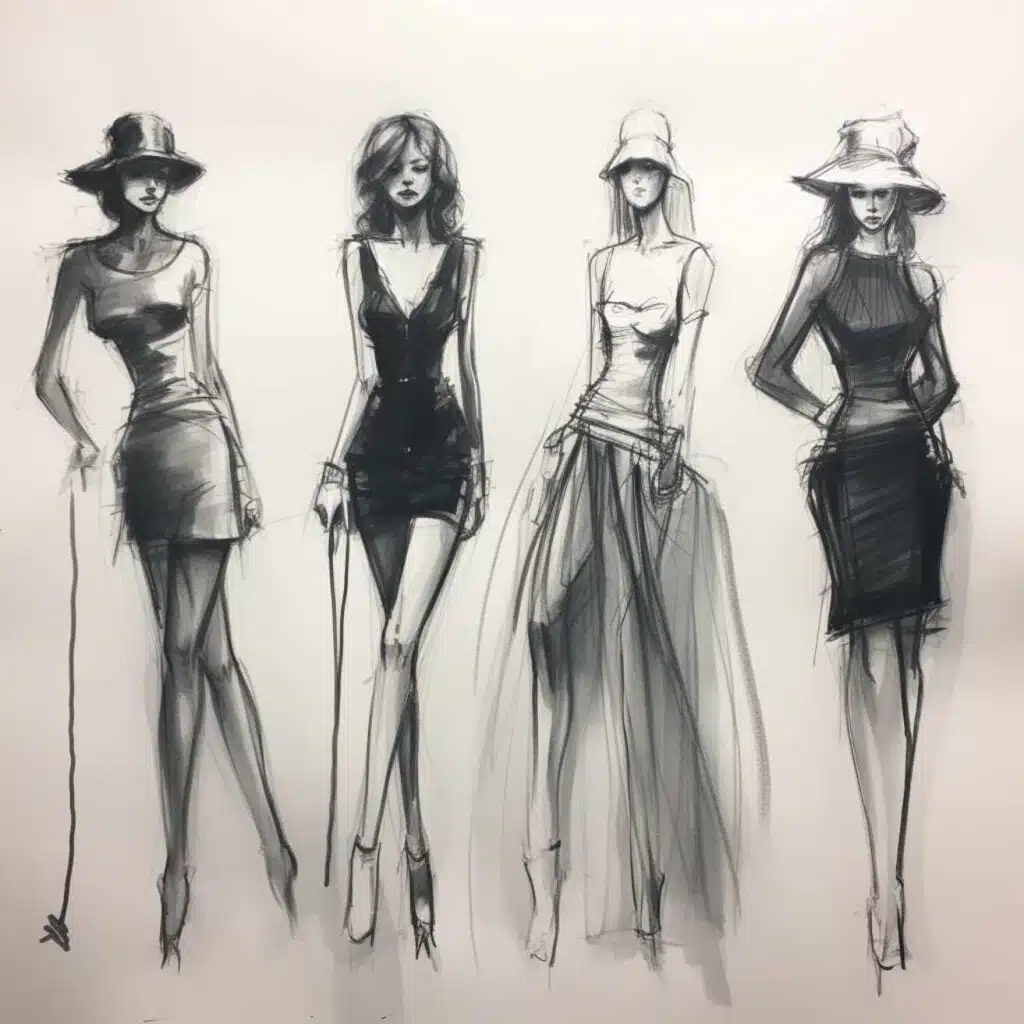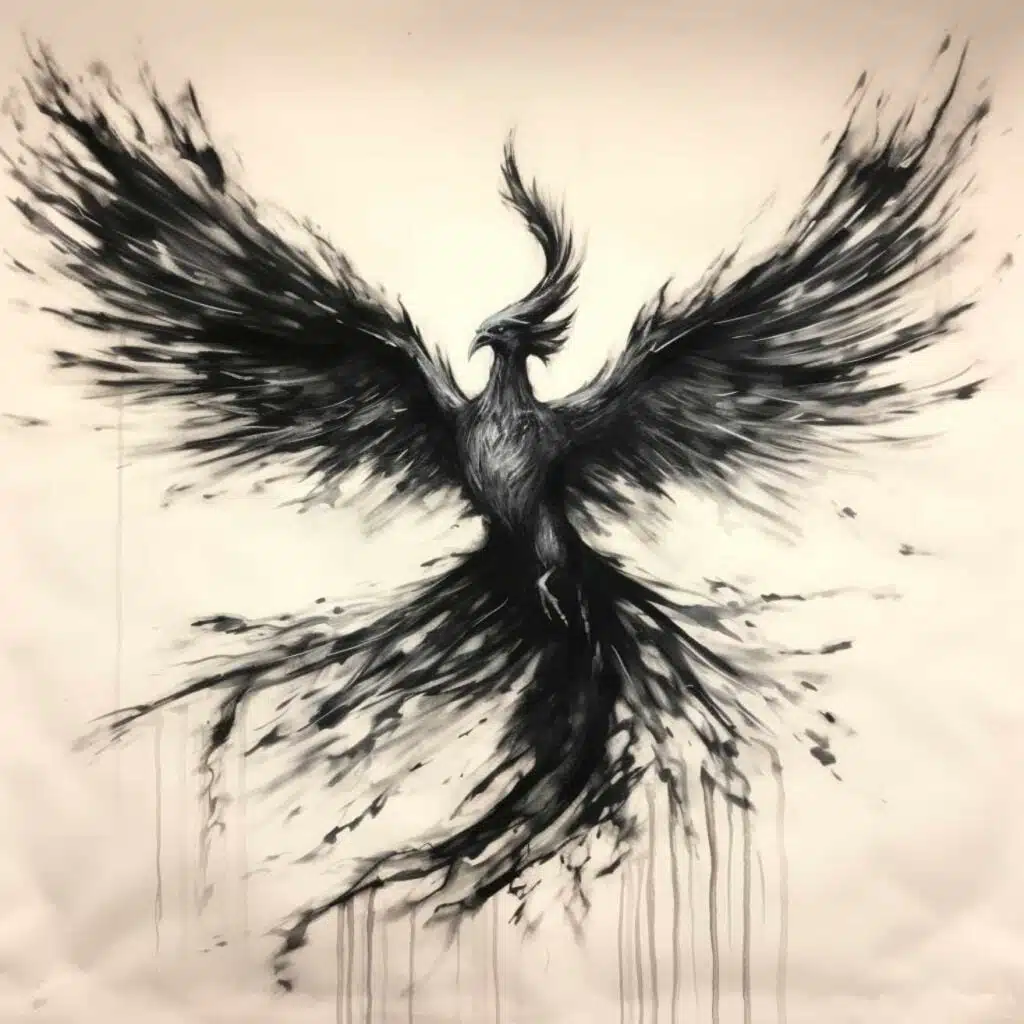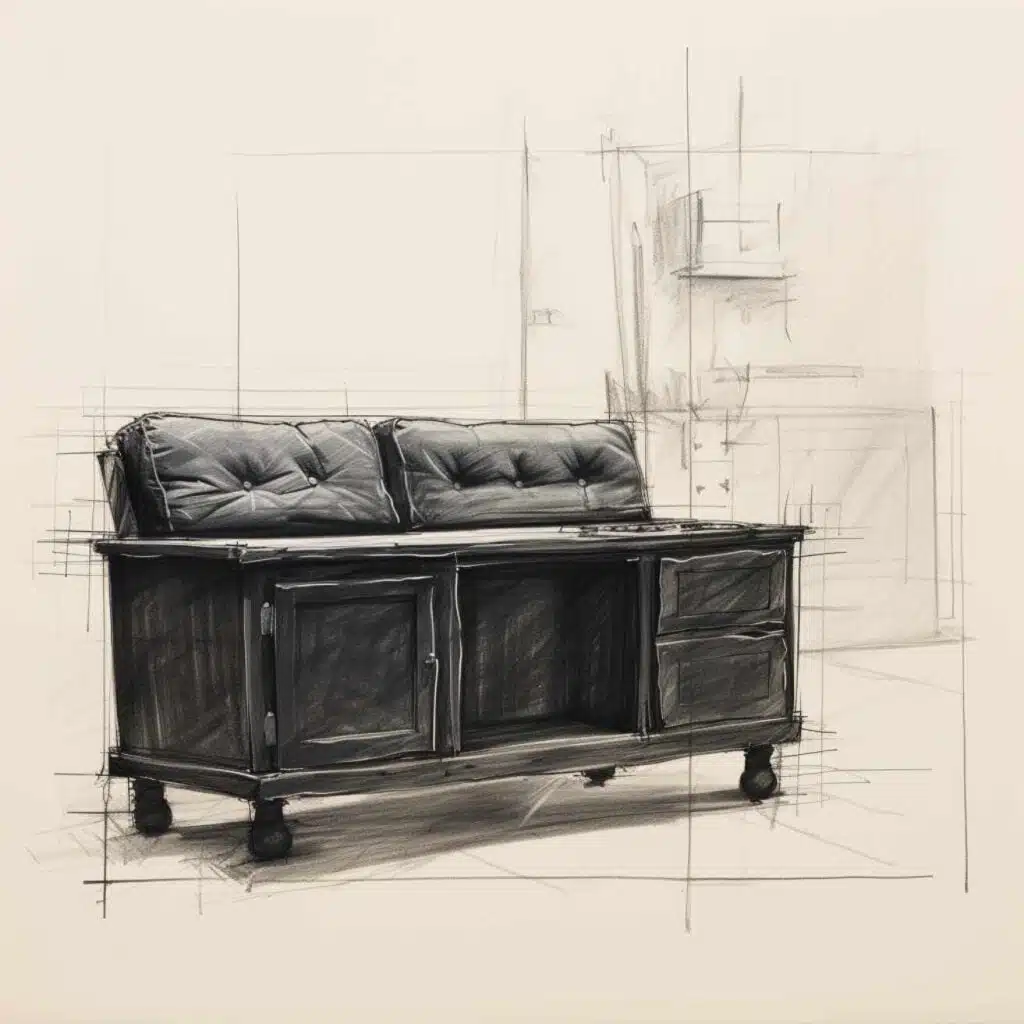Last Updated on August 22, 2023 by Dee
Charcoal drawing is a deeply satisfying and versatile art form that has captured the hearts of artists for centuries. With its smooth yet brittle texture, charcoal allows you to create stunning visuals with a wide range of shades and textures.
In this article, we explore the world of charcoal drawing with 20+ Creative Charcoal Drawing Ideas to inspire your creativity and fill your sketchbook!
20+ Charcoal Drawing Ideas
Portraits
Capture the essence of a person using charcoal. The medium allows for a wide range of tones and details, making it perfect for drawing subtle facial features and expressions.
Still life
Experiment with light and shadow by drawing simple everyday objects. Charcoal is excellent for depicting textured surfaces and creating dramatic contrasts.
Animals
Practice illustrating the form, texture, and movement of wild or domestic animals. The versatility of charcoal makes it ideal for capturing fur, feathers, and other animal features.
Landscapes
Record the beauty of nature through myriad shades of charcoal. You can create a sense of depth, atmosphere, and perspective by working with this medium.
Abstract art
Let your imagination run free by using charcoal to create expressive and emotional works of art.
Botanical drawings
Depict the intricate details and elegance of plants, flowers, or leaves using charcoal’s rich tonality.
Cityscapes
Capture the energy and architecture of urban environments. The diversity of charcoal’s strokes and intensities make it fitting for sketching buildings and streets.
Figure drawing
Hone your skills in anatomy by practicing figure drawing. Charcoal enables you to render the human body’s contours and forms with precision and fluidity.
Nautical scenes
Illustrate seaside vistas or marine life using charcoal, which can render the aquatic world’s distinct light, shadows, and textures.
Night scenes
Embrace the challenge of rendering nighttime environments by exploiting charcoal’s ability to capture gradations of darkness and light sources.
Weather effects
Convey the force of nature by drawing powerful weather phenomena like thunderstorms, rainfall, or blustery winds.
Historical events
Envision and depict historical moments or reimagine scenes from your favorite stories or novels.
Fashion sketches
Utilize charcoal to capture the flow and texture of fabrics, presenting stylish outfits or designs.
Food illustrations
Practice your skills by drawing your favorite dishes, showcasing the details and textures of various types of cuisine.
Caricatures
Experiment with exaggeration and distortion to create humorous depictions of public figures, friends, or family members.
Mythological creatures
Let your creativity soar by illustrating fantastical beings from folklore, mythology, or your imagination.
Technical drawings
Use charcoal for architectural or engineering sketches, appreciating the medium’s adaptable nature while maintaining precision and accuracy.
Famous masterpieces
Pay homage to your favorite artists by recreating iconic artwork in charcoal, gaining valuable insights into their techniques.
Concept art
Develop original ideas for future projects, whether it be a movie, comic book, or any other creative pursuit.
Symbols
Explore the meaning and interpretations of iconic symbols, ascribing your personal touch to them with charcoal’s unique characteristics.
Fundamentals of Charcoal Drawing
**This page may contain affiliate links to products I have used or recommend. If you purchase something from this page, I may receive a small percentage of the sale at no extra cost to you.**
First, its important to consider the charcoal you’ll be using. Charcoal comes in various forms, such as compressed, vine, and pencil.
Compressed charcoal is denser and produces a deep black tone, while vine charcoal is lighter and more forgiving, making it great for quick sketches.
Charcoal pencils are useful for detail work and control. You can mix and match these forms to achieve the desired effects in your art piece.
Next, consider the type of paper you’ll use for your charcoal drawing.
A heavier, textured paper holds the charcoal better, allowing you to create rich shades and bold contrasts.
Consider using a charcoal-specific or pastel paper to make the most of your drawing experience.
When creating your charcoal composition, it’s important to remember the fundamentals of drawing, such as:
- Lines: Use lines to establish the basic structure of your artwork. Start lightly with vine charcoal, then transition to compressed charcoal or charcoal pencils for darker, more definitive lines.
- Shapes: Break your subject into simple geometric shapes and focus on capturing the overall form. This will help you build a solid foundation before moving on to the details.
- Tones: Build up your drawing with a range of tones, from the lightest to the darkest. Experiment with layering and pressure to create a broad spectrum of grays and blacks, giving your art piece depth and dimension.
- Texture: Charcoal is an excellent medium for creating textures. Use various techniques, like smudging, stippling, or erasing, to produce a variety of realistic textures and effects.
Remember to keep a light hand when using charcoal; avoid pressing too hard, as it may be challenging to erase or lighten areas if needed.
Additionally, you can use tools like a kneaded eraser or a blending stump to refine your work and create seamless transitions between tones.
Materials and Tools
First, let’s talk about the different types of charcoal you’ll likely encounter.
The most common types are willow, compressed, and white charcoal pencils.
Willow charcoal is soft and easy to erase but can break easily.
Compressed charcoal is much harder and darker, creating intense shadows and shading.
White charcoal pencils are used to produce lighter tones and highlights.
Additionally, you’ll need a few types of erasers in your arsenal. A kneaded eraser is versatile and perfect for lightening areas, fixing small mistakes, and creating soft highlights.
A harder, white eraser might come in handy for more precise erasing and refining your drawing.
Understanding shading is a crucial aspect of charcoal drawing, as it helps to create a sense of depth and realism in your artwork.
To achieve a variety of tones and shadows, you can experiment with different drawing techniques, such as hatching, cross-hatching, or stippling.
Changing the pressure applied to the charcoal medium will also play a big role in creating different tones and marks.
To ensure a comfortable and practical drawing experience, consider investing in an easel.
An easel can help you establish the proper posture while providing an ideal artwork surface. Working vertically also prevents charcoal dust from smudging your drawing unintentionally.
Blending is another essential technique for creating smooth transitions between tones and textures. Useful blending tools include a tortillon (a paper blending stick) or a chamois cloth. Blending can soften your marks and even out your shading, giving your drawings a more polished appearance.
In addition to an easel, you’ll want various paper types for different effects.
Choose heavier-weight paper with some tooth or texture to hold the charcoal more effectively.
Toned papers can also help to create a more dynamic range of lights and shadows in your art.
Lastly, to preserve your charcoal drawings, always use a fixative spray. It prevents smudging and helps maintain the vibrancy of your artwork.
Techniques and Tutorials
Friendly reminder: practice makes perfect! Your charcoal drawing journey will be fun and engaging, especially as you experiment with different techniques and tools.
Here are some ideas and tutorials for charcoal drawing success.
Charcoal Types: Remember to choose both hard and soft charcoal. Hard charcoal will give you cleaner edges, while soft charcoal is perfect for blending and creating darker lines.
Composition: Focus on the essence of your subject matter. Arrange the elements in your drawing to create a strong composition that draws attention to the main idea.
Powdered Charcoal: As an alternative to charcoal sticks, you can use powdered charcoal for delicate shading and blending. Apply it gently with a soft brush, and don’t forget to seal your artwork with a fixative to prevent smudging.
To help you master these techniques, check out the following resources:
- Charcoal Drawing Tutorials: Try searching for step-by-step tutorials on YouTube. These videos offer valuable tips and demonstrate various methods in real-time.
- Books: Visit your local bookstore or library for a selection of books dedicated to charcoal drawing tutorials and ideas.
As you explore and apply various charcoal drawing techniques, feel free to experiment with the following tools:
- Blending Stump: Use a blending stump to smoothly blend charcoal lines and create gradients. They’re perfect for creating realistic textures.
- Soft Charcoal Pencil
- Charcoal Powder
- A Charcoal Stick
- Kneaded Eraser: Kneaded erasers are essential for “lifting” charcoal off the paper. Shape the eraser as needed, and carefully remove or lighten areas for clean highlights.
- White Charcoal (or a White Charcoal Pencil) : Don’t hesitate to incorporate white charcoal or pastels into your drawings. They’ll add depth and contrast, making your artwork even more dynamic.
Subjects and Styles
Charcoal drawing offers a vast array of subjects and styles to explore and refine your artistic skills.
In this section, we’ll look at a few popular subjects like portraits, landscapes, and still life, while also discussing the use of various charcoal tools such as vine charcoal.
Portraits
Charcoal is an ideal medium for capturing the essence and emotion of a human face.
When you’re working on a portrait, begin with lighter strokes of vine charcoal to establish the basic facial structure.
This will allow you to easily make corrections and adjust proportions before committing to darker and bolder marks.
Gradually build up the values, paying attention to the subtle shifts of light and shadow that define the features, and allowing the expressiveness of your subject to emerge.
Landscapes
When creating a charcoal landscape, remember that your primary goal is to evoke a sense of space and atmosphere.
Begin by lightly sketching the main elements of your scene with vine charcoal, focusing on composition and balance.
Then, apply a layer of powdered charcoal to tone the paper and provide a foundation for your values. With a kneaded eraser or a soft brush, lift out areas of light and emphasize shapes that recede into the background.
Adding darker values with a compressed charcoal pencil will help convey depth and bring your landscape to life.
Still Life
Still life is an excellent opportunity to practice your observation skills and discover the beauty in everyday objects.
Set up a simple arrangement of items with a variety of shapes, textures, and values.
Start by lightly sketching the composition’s overall structure with vine charcoal, accurately representing proportions and relationships between objects.
Progressively build up your values by layering different types of charcoal like hard and soft charcoal pencils, using erasers to create highlights and clean edges.
Utilizing vine charcoal for the lighter areas can help capture the subtle shifts in light and form.
Advanced Concepts
Creating depth and dimension in your charcoal drawings can elevate your artwork to new levels.
Consider using different tones and shades to add depth, from the lightest to the darkest.
Remember, contrast is your friend when working with charcoal. Boldly apply the charcoal to your paper to create darker areas, and be gentle when creating lighter areas.
Blending is essential when building up layers and adding depth to the drawing.
Incorporating various textures into your artwork can also help you convey emotions.
To achieve this, experiment with different techniques, such as cross-hatching, stippling, and smudging.
Each technique will produce varying effects, allowing you to create unique textures and capture the viewer’s attention.
When it comes to expressing your creativity, don’t be afraid to take risks and step out of your comfort zone.
Remember, charcoal is a flexible medium that can be easily corrected if something doesn’t work. Feel free to mix and match techniques, styles, or even combine charcoal with other mediums, such as pastels or acrylics. This fusion of materials can lead to exciting and unexpected results.
As you work on your charcoal drawing, one crucial aspect to keep in mind is how to convey the emotions and feelings you want your artwork to evoke.
This may mean selecting specific subjects to represent certain emotions or placing focus on capturing facial expressions, body language, or the overall atmosphere of a scene.
Tips and Tricks
When it comes to charcoal drawing, there are a few techniques and tips that can help you create impressive artwork.
First and foremost, pay attention to your wrist and elbow movement. Keep your wrist relaxed while using your elbow and shoulder to create larger strokes.
This will give your drawings a more dynamic and expressive feel.
Next, try mastering the art of cross-hatching.
This technique involves drawing intersecting lines to create different tonal values. Use a light hand and gradually build up layers to achieve various shades and textures.
Remember, practice makes perfect, so don’t be afraid to experiment with different combinations of strokes and angles.
To create realistic and lively drawings, observe nature closely. Study the textures, shapes, and tonal values you see in natural objects, and try replicating them in your artwork.
You can also use photographs or still-life objects as references to improve your observational skills and understanding of light and shadow.
Incorporate white chalk in your drawings to add highlights and bring a unique depth to your artwork.
Using white chalk on dark charcoals can produce beautiful, dramatic contrast that will make your subjects pop. Just be mindful not to overdo it, as too much white can sometimes overpower the drawing.
Don’t forget to explore the world of geometric shapes. Break down complex subjects into simple shapes like circles, rectangles, and triangles to make drawing easier.
This approach can help you better understand proportions and the relationships between different elements in your artwork.
Remember to keep a friendly and patient attitude when working in charcoal. It will undoubtedly be messy, but with practice, you’ll find that you can create stunning art pieces that bring out the best of this versatile medium. Happy drawing!
Paper and Surfaces
In your charcoal drawing journey, it’s important to choose the right paper and surfaces. Let’s explore some common types and their suitability for charcoal drawing.
Charcoal paper is specifically designed for charcoal drawings, with a textured surface that holds the charcoal particles really well. It’s a great option for your artwork, as it’s not too heavy and can handle multiple layers of charcoal without deteriorating.
Newsprint is a lightweight, inexpensive option perfect for practicing your skills. Since it’s less durable than other papers, it’s better suited for quick sketches and studies rather than finished drawings.
Toned paper comes in various colors and the mid-toned background can add depth to your drawings. Using white charcoal or pastels on toned paper can help you create stunning highlights.
Illustration board is a heavier, more durable option providing smooth and rigid support. It’s suitable for creating detailed and finished charcoal drawings.
Textured paper can add an interesting element to your artwork. The uneven surface creates a unique effect as it picks up and holds the charcoal particles in the grooves.
Drawing paper is a versatile option, but it might not be as well-suited for charcoal as charcoal-specific paper. However, some heavier-weight drawing papers with a slightly textured surface can work well.
Cartridge paper is another readily available and affordable option. While it’s not specifically designed for charcoal, its smooth surface can still handle light to medium applications.
As you explore charcoal drawing, feel free to experiment with these different paper and surface options to find your personal preferences.
Inspiration and Ideas
As you venture into the world of charcoal drawing, it’s essential to derive inspiration from a variety of sources. Remember, your creativity flourishes when you explore different ideas and techniques.
Here are a few friendly suggestions to get you started:
To begin with, still life charcoal drawings provide an excellent opportunity for practicing technique while creating stunning compositions.
Set up a selection of objects such as fruit, flowers, books, or even wine bottles on a drawing board. Pay attention to the arrangement as you draw, focusing on the shapes, shadows, and textures.
If you’re looking for easy things to draw, consider creating basic forms using different types of charcoal like willow charcoal, along with hard charcoal and soft charcoal.
These materials will allow you to experiment with various shades, smudging, and textures.
Portrait drawing is another fascinating subject matter to explore. Try capturing the essence of a person using charcoal and observe its unique effects. From subtle facial expressions to intricate details, charcoal drawings can easily capture the subject’s mood.
When working with charcoal, it’s crucial to familiarize yourself with various tools and accessories. One of the essential tools is the chamois – a soft, porous cloth that helps you blend and smudge the charcoal effectively.
With this tool, you can manipulate the charcoal, creating an array of textures and effects.
Kneaded erasers are another must-have charcoal drawing tool. They are flexible, easily moldable, and perfect for lifting off the charcoal from your drawing surface. Experiment with using the eraser to create highlight effects and to clean up edges on your charcoal drawings.
Frequently Asked Questions
What are some popular techniques for charcoal drawings?
There are several popular techniques used in charcoal drawings, such as hatching, cross-hatching, shading, and blending. You can experiment with these techniques to add depth and dimension to your work. Additionally, don’t be afraid to try the reductive drawing technique, where you create art by erasing charcoal after applying a dark tone to your paper.
How can I hone my charcoal drawing skills?
To improve your charcoal drawing skills, practice regularly and experiment with different types of charcoal, such as willow, vine, and compressed charcoal. You can also learn from experienced artists by attending workshops, watching tutorial videos, or reading books on the subject. Remember, the key to improvement is persistence and patience.
What are the essential tools for charcoal drawing?
Some essential tools for charcoal drawing include various types of charcoal (willow, vine, compressed, and powdered), charcoal paper, white and kneaded erasers, a chamois, tortillons, white charcoal or pastel pencils, and fixatives to help preserve your work.
How can I create texture in my charcoal art?
To add texture to your charcoal drawings, you can use different application techniques, such as hatching, cross-hatching, stippling, or scribbling. Experiment with smudging and blending to create smooth gradients and transitions. Also, don’t be afraid to use unconventional tools like paper towels, cotton swabs, or even your fingers to help build texture.
What subjects are ideal for charcoal compositions?
Charcoal is a versatile medium that can be used to depict various subjects, such as portraits, landscapes, still-life, and abstract compositions. It’s particularly well-suited for capturing moody and atmospheric scenes due to its ability to create subtle tonal variations and rich darks. Feel free to explore different themes and subjects to find the ones that resonate with you the most.
How can I preserve and protect my charcoal creations?
To preserve and protect your charcoal drawings, use a fixative spray to seal the surface and prevent smudging. Make sure to do this in a well-ventilated area and apply the fixative according to the manufacturer’s instructions. Once the fixative is dry, handle your artwork with care, and if possible, frame it under glass or Plexiglass to provide additional protection.
Other articles you may enjoy…
Drawing Tools Unleashed: Top Picks for Every Artist
Fixative Spray for Charcoal: 13 Great Options

